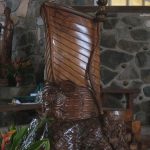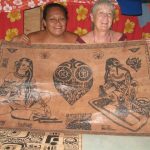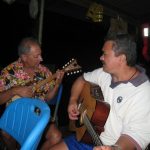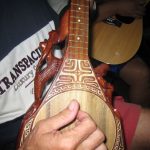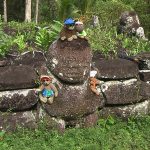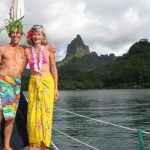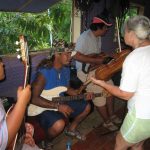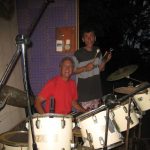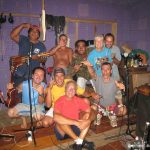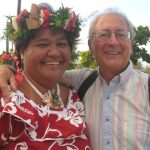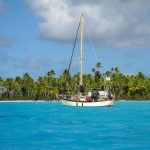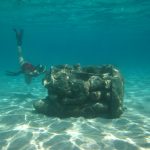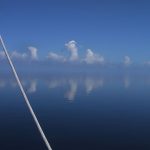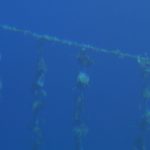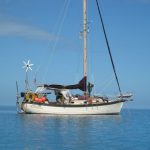June 2008
French Polynesia
French Polynesia is made up of five island groups,The Marquesas, The Tuamotu, The Gambier’s, The Societies, and the Australs. Upon our arrival, the Immigration officer made it absolutely clear that our visas would be good for only ninety days and there would be absolutely no extensions. We had much to see and very little time.
The Marquesas
Fatu Hiva
Fatu Hiva is the most windward of the islands and also without doubt the most isolated and typical of the Marquisian culture but unfortunately it is not a port of entry. It just happens to be the first island you come to after your long sea passage and it is tempting. Also, if you do not stop here along the way the chances of returning against the trades are very slim. We were advised by the Germans that they had researched the latest information completely and claimed emphatically that the regulations had been relaxed. It was now “acceptable” to stop in Fatu Hiva, report to the island chief and to visit for “a short time” before clearing in at Hiva Oa. Great! We got right to it.
There were no stores, no restaurants, no telephones and no internet but…there were hikes to waterfalls, authentic Polynesian meals in local homes as well as trading with them for fruit, vegetables, local clothes and works of art. And then there was the music. To die for! The harmoAfter a week of island bliss a French Customs boat arrived. We discovered that the “latest information” was wrong and each boat was fined $200.00 for our lapse. Despite this snag we thoroughly enjoyed our stay but we now had to move on, clear in and be official.
Hiva Oa, Thuata, Ua Po
Hiva Oa was our port of entry and we were now properly cleared into Polynesia. The French government requires everyone to post a bond for each person equal to one way air fare back to their country of origin. Between exchange rates, the falling US Dollar and bank fees this becomes quite expensive and complicated. We were advised that if we used an agent all of this complication and expense would disappear. This is a relatively new idea here and after our thoroughly negative experience with the required agent in the Galapagos we were very skeptical but in the end, we took a chance and were pleasantly surprised. Sandra and Laurent Beanrert of Polynesian Yacht Services were wonderful. As a bonus, we met Sandra’s husband David, a fine Jazz guitarist who introduced us to the local music scene.
Hiva Oa is more modern and up scale than Fatu Hiva. There were small markets with $10.00 cabbages and $4.00 beer but there were fresh baguettes in abundance for only .65 cents (baguettes are government controlled) and internet if you did not mind walking two miles into town to connect.
David invited us to play with his band so one evening we were taken up into the hills and quite surprised to find a state of the art digital recording studio overlooking a spectacular view of the Pacific Ocean. We played on two recording sessions with the boys and while we could communicate with them in French, we still to this day have no idea of what the songs say as they were all in Polynesian. It is true that music is the universal language. We even got paid for our efforts with huge bags of pamplemouse (grapefruit the size of soccer balls).
In Tehuata we met Francisco Savage on his Westsail 32 Infini. Francisco is from Vanuatu and he provided us with some wonderful insights into the life and culture of these islands. He is only 23 but he is without doubt the most fascinating person we have ever met.
The winter trades were now in full force and we sat behind the sea wall in Ua Pou waiting for a break. We continued to receive regular weather advice from Mr. Johnway up in Mexico. For some reason he seemed to have a special interest in our weather system and sadly, offered us no hope for improvement. Nuku Hiva was only twenty –five miles away so we decided to just get on with it and tough it out.
We finally we arrived at Taioahe Bay on the Big Island of Nuku Hiva after six hours of the most rugged sailing we have ever done, EVER! As we arrived in the harbor we spoke to a group preparing to get under way for the Tuamotu that night and we told them “Anyone who leaves this harbor to go out there tonight is nuts!”
Taioahe is the largest and most well known settlement in the Marquesas. Through the years, every famous sailor has stopped here so we were in good company. Taioahe Bay and the smaller village of Taipi Vai were made famous by Herman Melville in his smash best seller Typee way back in 1846. For a week we explored the island and valley of Taipi Vai which seemed largely unchanged from Melleville’s time. There were several nice markets, though expensive, we could provision for our stay in the remote Tuamotu before carrying on to Tahiti.
Whenever you are away from home and have family health problems back home, it’s tough but here things became impossible. We received an e mail that Ellen’s mother had been hospitalized for a heart problem and though recovering, needed assistance. We decided on a simple plan that when we arrived in Papeete Ellen would fly home for a few weeks to assist the family. I would remain in Tahiti until her return and then we would move on to New Zealand. Alas, that was not to be. Immigration told us that the type of visa we were issued would expire as soon as Ellen departed Tahiti. This meant that Ed would have to single hand to American Samoa and Ellen would fly there and miss Tahiti. The only other choice would be to leave Entracte in a boat yard and both of us fly home, remain out of Polynesia for the required time and return with brand new ninety day visas. The good news with this plan was that we could allow more time in Tahiti and we would miss the hurricane season as well. Not a bad choice at all. We made our reservations and went back to enjoying ourselves. We did have until August 21 and the Tuamotu ahead of us.
The Tuamotu—Rangiroa, Makemo, Kaitu, Fakarava and a thousand more!
The Tuamotu are historically referred to as “The Dangerous Archipelago” and with good reason. They are dangerous to find, dangerous to enter, dangerous to anchor, dangerous to cross and dangerous to leave. Aside from that they are quite beautiful.
The distance from Nuku Hiva to the Tuamotu is just under five hundred miles or about four days. That’s the easy part. The trick is to arrive at the right cay at the right time with the right sunlight and the right sky avoiding the other cays and reefs along the way. The currents between the cays are swift and tricky.
On our fist landfall we had the sun in the right place and the sky was clear but according to our calculations we were five minutes late for slack current. It looked safe enough but as we approached the entrance to the pass we discussed the warnings of the old timers and decided that “we missed it.” We turned seaward to lay off shore until the next slack period. Two minutes later it was as if someone suddenly flushed a giant toilet. Within seconds, the current ran at , the water boiled, the waves built to a respectable height and slammed aboard as the current reached an incredible TEN KNOTS and shoved us seaward. We escaped just in time. Had we turned seaward a minute later or been in the pase it would truly have been a bad day. Four hours later we were safely inside and truly anchored in Paradise.
The Tuamotu are a collection of numerous small cays each ringed with a dangerous coral reef. They are very low to the water, are unlit and devoid of the usual lighted navigation buoys. In the old days they were very difficult to find and many a ship ran onto the reefs before sighting the cays themselves. Today with GPS navigation finding them is not a problem but…..!
Constant vigilance is an absolute must, even with GPS. Because the entrance passes require diligent eyeball pilotage amoung scattered reefs and coral heads, good sunlight and a clear sky are a must. It is also imperative to arrive at the entrance to the pass at slack current—JUST! If you miss this time by as much as five minutes the current will suddenly turn against you at up to ten knots and you will be out of control in a very, very bad place. To see a forty foot boat spun round and round in a whirl pool is not funny.
The beauty of the Tuamotu lays in their isolation the abundant pearl farms and the turquoise water. We spent a delightful month diving, relaxing and dodging pearl strings as we sailed across the motus. The wind was really howling day after day. It was July and winter in the Southern Hemisphere. Outside the pase, the seas were huge but because each motu is actually a giant coral reef with a lake in the center, the reef provides a constant barrier from the seas. We sailed in relative calm, however; we had to maintain a constant lookout. We would be sailing along at five knots in three hundred feet of water when suddenly a huge coral head would rise to within a few inches of the surface. If you failed to spot it in time you could run up on that reef to be stranded or sunk. The few pearl farmers that are there have absolutely no facilities with which to help. You are on your own! The Tuamotu are littered with the wrecks of the careless, including Sterling haden’s Wanderer (aka The Tiki of Adventures in Paradise fame).
We heard again from Mr. John, this time by radio. “GREAT SIGNAL JOHN! Sounds like you are right next door!” He finally came clean. He WAS next door! They were NOT in Mexico after all but in Tahiti. They had finished with Mexico and decided to sail 3000 miles and surprise us. That explained his interest in OUR weather. He was right behind us all the time. While we were hanging on in Ua Pou they were in Nuku Hiva trying to get to us but because of the strong winds could not get to windward. They fell off and made for Tahiti. We made a plan to rendezvous in Huahine in a month’s time. Great surprise!
Now we had two reasons to press on. It was also their festival time in Tahiti. Bastille Day was coming and we wanted to be there for the festivities. Off we went. 200 miles to Tahiti.

